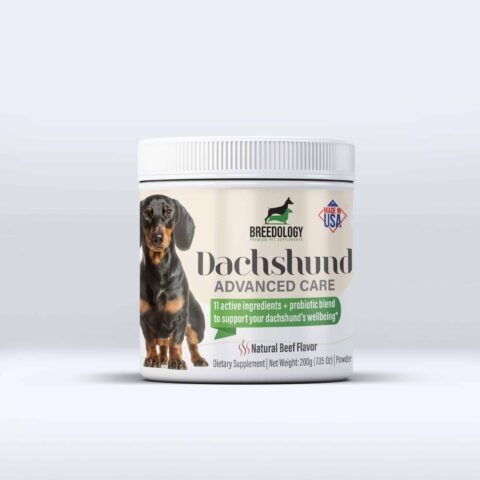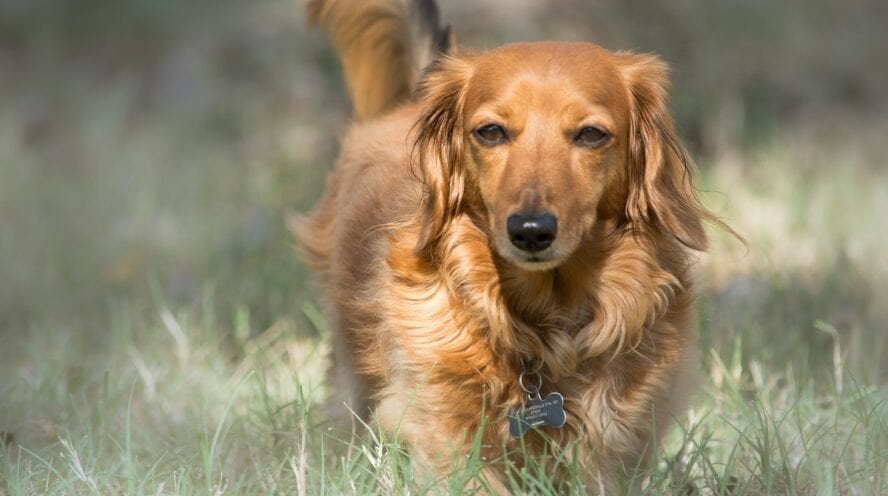Dachshunds are undoubtedly the world’s biggest charmers with their enormous personalities in these adorable little “sausage-like” bodies. While dachshund’s unusual body shape contributes to their fame and popularity, there are some downsides that the weiner dogs face. Certain issues, like leg problems in dachshunds, should be addressed very seriously, as they can affect your pet’s quality of life.
The short legs and elongated body of dachshunds are actually a form of dwarfism. While most sausage dogs go through life with healthy joints, some are not as lucky and sometimes suffer from severe limb problems.
If you’re worried that your dachshund might have leg problems or if you’re interested in preventing them, then please keep reading.
It’s important to note that you can manage most of these health issues, and your dog can have a long, happy life even if it happens to have problems with its limbs.
Disclaimer: This is not a medical article, and you should always consult your vet if you think your dachshund has spine or leg problems.
Leg Problems In Dachshunds: What Are They?
Just as in humans, dwarfism in dogs may cause the bones to grow in abnormal ways, leading to bone deformities and stressed joints. This condition can cause physical discomfort pain if left untreated.
Dwarfism in dogs is a genetic condition and can’t be prevented, but you can effectively manage possible unpleasant outcomes.
Now, let’s discuss what specific leg problems dachshunds can have and how to prevent them.
Bowlegged syndrome
One of the most unpleasant leg problems in dachshunds is called pes varus, or bowlegged syndrome.
As the name suggests, this condition causes the hind legs to bend and the bones to get deformed. Specifically, the bone called the distal tibia gets turned inwards towards the body and can cause pain.
In severe cases, the only solution is surgery to straighten out the bones and make walking more comfortable. The surgeon cuts the bone to realign it and then places a cast.
There’s no need to worry just yet – severe cases of this genetic condition are still pretty rare. If left untreated, though, pes varus can cause early arthritis, so it’s a good idea to keep an eye on your pup if its hind legs look abnormal.
Antebrachial growth deformity
Antebrachial growth deformity is another leg problem that dachshunds might have. Unlike when it comes to pes varus, this condition affects the front legs rather than the hind legs and causes one of the front legs to grow larger than the other.
Dogs with this deformity will have an uneven posture which puts a lot of stress on the joints and can be painful. Again, surgery might be necessary to correct this leg problem in dachshunds.
Elbow dysplasia
Another issue that dachshunds might have is known as elbow dysplasia. In this case, it’s the elbow joints that are deformed, and since they consist of three different bones, deformation in these joints will distribute the weight unevenly, causing both pain and possibly arthritis.
In very mild cases, your dog might only need medical management, but often the only way to correct a deformed elbow is to have surgery.
Luxating Patella
It’s not only the elbows that can become troublesome but the knees too.
Luxating Patella is a common health condition that affects the dachshund’s hind legs.
Patellar luxation happens when the patella (kneecap) becomes displaced or misaligned.
At the initial stage, the kneecap can slides in and out of place, especially during movement. A kneecap that tends to dislocate might not be a big issue per se, but it can lead to other injuries. Since the surrounding joints get more stressed, it can also cause arthritis.
Luxating Patella also tends to worsen with time, making it more challenging to perform a successful surgery.
Leg Problems In Dachshunds: What Are The Signs?

So, now that you’re familiar with some of the fairly common leg problems in dachshunds, you might ask the following questions:
- How can I know whether my dachshund is suffering from one of them?
- What are the symptoms that I need to look out for? When should I contact a veterinarian?
Well, when it comes to pes varus or bowlegged syndrome, you can tell just by looking at the position of your dog’s hind legs.
We all know that dachshunds’ legs are slightly curved. But do they point in or out at an awkward angle? It often becomes apparent before the dog is fully grown, but this condition can also develop later, so keep an eye on it.
As for antebrachial growth deformity (when one front leg is longer than the other), it can also be visible when looking at how your doxie stands. However, it might be even easier to see when your pup is walking, as there might be a rather obvious limp.
Spotting any leg problems in dachshunds is easier if you pay attention to how your dachshund normally moves. This way, you can easily see any differences in movement and behavior. Shorter steps might indicate that something is wrong, as might stiffness, to the hind legs especially.
You might also notice that your dog isn’t moving as freely as before and that his range of motion has been limited.
- Perhaps he’s not as playful?
- Won’t run as fast? Doesn’t seem in a good mood?
Pain is also an indicator that something is off and might need a vet’s attention. If you can see that any joint is swollen, this might be a symptom too, just like limpness.
If your dachshund has experienced any of these symptoms and they won’t go away, it’s a good idea to book an appointment with a vet.
Better safe than sorry, right? Many joint conditions worsen over time, so a prompt visit to the vet can save you several visits in the future!
The best way to help your dachshund live longer?
Watch our video to find out!
My Dachshund Suddenly Can’t Walk: What Do I Do?
If your dachshund is suddenly shaking or seems paralyzed and unable to walk, it is almost always a sign of spinal issues.
Even though it’s the legs that seem to be affected, the immobility is often caused by slipped (herniated) vertebrae which means it’s a spinal problem rather than an issue with the front/back legs.
To determine where this herniated disk might be located, try to work out which legs seem to have lost their function.
Front legs? That means the problem most likely is in the neck area. Hind legs? The issue is further down the spine.
The next thing to do is try to restrict your dachshund’s movement and keep the affected area (back or front) as still as possible.
Next up is calling your vet. If the injury occurs after office hours, you might have to visit the emergency clinic. Time is of the essence here, so try to make sure you see a vet as soon as possible.
Once you’re there, tell the vet if it’s the front or hind legs affected and how it happened, and when. Any information will help the staff to diagnose the issue more accurately.
You might also want to read up on Intervertebral Disk Disease (IVDD), as it is by far the most common back injury in dachshunds. We wrote a separate detailed article on it.
Leg Problems In Dachshunds: Treatments and Prevention

As we’ve seen, many leg problems in dachshunds might require surgery. It is specially true if the issue has been left untreated for too long.
Other treatments include crate rest, as well as pain killers or other medical management recommended by your veterinarian. Sometimes you’ll just be asked to wait and see if and how quickly the condition develops.
However, if you’re not willing to rely purely on luck, there are other things you can do to try to prevent any issues with your dachshund’s legs or spine in the future.
One of the most important and effective preventive measures is Supplementation.
We highly recommend the Dachshund Advanced Care by Breedology, it is an advanced dietary supplement, precisely formulated for the dachshund breed. Their powerful formula includes Chondroitin, Glucosamine and Hyaluronic Acid among other ingredients that work in perfect synergy to provide advanced joint and cartilage support.

Excessive weight puts a strain on your doxie’s joints – joints that might already be genetically weak or deformed.
Besides a good diet (you are often going to have to say no to those puppy eyes begging for a snack!), regular exercise will keep your dachshund happy and healthy. Daily walks are definitely a win-win!
Similarly, other things might put unnecessary stress on your dachshund’s joints and spine, such as going up and down stairs or jumping onto furniture or into the car.
Instead of letting your dachshund freely on your sofa, you might want to assist your pup and lift him to where he wants to be. Make sure to use both your hands, though, so that both the front and back are supported!
Another great solution is dog ramps; you will find a great selection in our shop.
It is important to remember not to overexercise your dachshund puppy, making sure that the still-developing joints don’t get over-worked.
Some experts say that five minutes of walk per month of age twice daily is an excellent guide to follow. That means that a pup that’s three months old can exercise for 15 minutes two times a day, and so on.
If you’re a breeder, you can also do your part by not crossbreeding dachshunds with leg or back problems. IVDD is a genetic condition and can be reduced considerably with responsible breeding.



Comments
My one year 5 month old Piebald Gracie has bow legged back legs. My vet has examined her and her patellars are good. She is very healthy, beautiful markings, with a wonderful temperament. I would like to know if I should not breed her because of her pes verus syndrome ? I plan to do genetic health tests on her. The male is in perfect Heath with all genetic test results great except for the possibility of IVDD which I understand the testing always shows this possibility . Please advise me about breeding her. Will she pass this condition on to her puppies? If so I will not breed her. Thank you
As I understand, your dachshund was diagnosed with Per Varus orthopedic disorder?
Pes varus is a rare condition in dachshunds and hasn’t been researched properly. However, the geneticists agree that this is a genetic-based problem.
Experts suggest that the condition is inherited, and affected puppies inherit a copy of the gene mutation from both the sire and dam parents. Carriers can not be affected by the disease but can pass the mutant gene to their offspring.
A good article regarding this topic is here:
https://www.purinaproclub.com/resources/dog-articles/health/breeder-education-part-of-effort-to-raise-awareness-about-pes-varus
Thank you for using my photo from Pixabay.
Hi I have a mini dashound called bernie he is is now 6 months old and yesterday the vet confirmed that he has pes varus in both back legs he isent in any pain and very active not sure wether to stop two walks a day he has a ramp for tye settee any advice would be great
Hi Denise, unfortunately we cannot give a veterinary advice. The best would be to schedule a visit with a veterinary surgeon.
Hello, my mini Dachshund is Ezme, she is 11, i built ramps and trained for no steps and inevitably we now have calcified disks. Vets give pain meds but I’m also using cbd oil from an online UK bonified supplier. It helps so much. Just wanted to let you know.
Hi Laura can you send me the CBD oil place I live in the States though do you know one in the States vs. UK?
My dachshund has leg issues
thanks Danielle
Hi I have a 2 week old puppy that seems to have one paw that won’t stay upright when she is starting to try and stand. It almost looks like it’s missing tendon or ligaments. At the joint above the paw it collapses outwards
We have two minis and a Chiweenie. The Chiweenie is 17 years old and I am wondering how to keep her back foot from clubbing under. We rescued her years ago and she had been overweight with previous owner and she had a herniated disk with much calcification. Her back was broken and after much PT, including acupuncture and water therapy and rehab, she was able to walk and run again. However, I have been working with her and wonder about a device I saw on Amazon which fits around the leg and has what look like black rubber bands that go under the two middle toes to keep the foot from clubbing while I walk her. Just need your opinion so I can continue to walk/exercise her to keep the strength up in her back legs.
With kind regards,
Andrea
Hi An, I think it is worth trying considering it will improve her walking, and won’t cause any pain/discomfort. If physiotherapy doesn’t help any further with this neurological problem, unfortunately there is not mush else you can do.